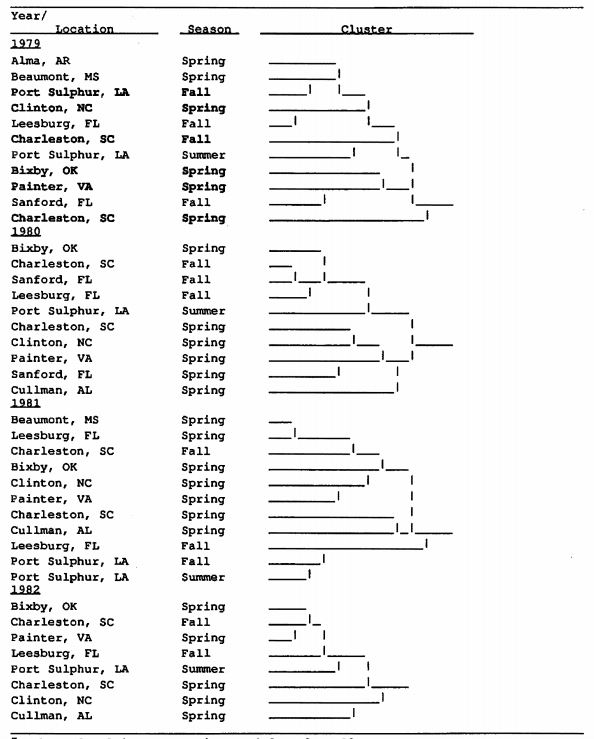Cucurbit Genetics Cooperative Report 11:13-14 (article 6) 1988
Todd C. Wehner
Department of Horticultural Science, North Carolina State University, Raleigh, NC 27695-7609
Plant breeders interested in developing slicing cucumbers for the southern U.S.A. often use the southern cooperative trials that cover many locations and seasons in that region. Trials use locations from Virginia (northeast corner of the region) to Texas (southwest corner). The cultivars and breeding lines (cultigens) evaluated over the years performed differently from one location to the next, but it appeared that some locations were similar. In order to determine which locations were most similar, a cluster analysis was run using data from trial summaries from 1979 to 1982.
Methods.
Data was taken from the U.S.A. Southern Cooperative slicing cucumber trials for 1979 through 1982. The number of locations ranged from 8 to 11 each year, and the number of cultigens tested ranged from 8 to 12. Data from the trials was subjected to the averaging method of cluster analysis using PROC CLUSTER from the Statistical Analysis System (SAS Institute, Cary,N.C.). The character used from the trial was yield, measured as weight of marketable fruits (cwt/A) from multiple-harvest of small, replicated plots.
The locations and cultigens differed from year to year as different cooperators helped run trials and as new cultivars were entered into trials, and old cultivars were discontinued. Therefore, it was not possible to run a combined cluster analysis over all years.
Results.
Clustering of locations using yield of different cultigens showed different patterns over the years (Table 1). In 1979, the Charleston, SC spring trial was most different from the other 10 environments. Clinton, NC spring and Leesburg, FL fall were most similar for yield of the cultigens tested. In 1980, the environments could be divided into 2 groups of 5 each. The groups corresponded roughly to eastern and western parts of the Southern Cooperative. The exception was that Charleston, SC and Sanford, FL appeared in both groups, with the fall season of each in the western group and the spring season of each in the eastern group.
The 1981 trials also could ne divided into 2 groups. Once again, the spring and fall seasons at Leesburg, FL and Charleston, SC fell into different groups. The Port Sulphur, LA summer and fall trials were similar to each other and to the Leesburg, FL fall trial. In 1982, the environments could be divided into 3 groups with Cullman, AL and Clinton, NC in the firs, Charleston, SC spring in the second, and the other 5 environments in the third.
Lack of funds for running trials have resulted in cooperators dropping out of the Southern Cooperative. Cluster analysis shows how the number can be cut back while still maintaining the representation for each group. For example, the 11 environments in 1979 could be cut back to 6 if necessary by using one environment from each cluster (Table 1, 1979, environments shown in bold face).
Table 1. Cluster analysis (average method) of locations in the U.S.A. Southern Cooperative slicing cucumber trials from 1979 through 1982 using marketable yield from multiple harvest of small plotsz.

Table 1. Cluster analysis (average method) of locations in the u. s. A.
Southern Cooperative slicing cucumber trials from 1979 through 1982 using
marketable yield from multiple harvest of small plotsz.
zNumber of cultigens tested ranged from 8 to 12 per year.